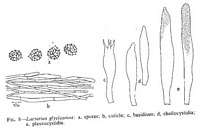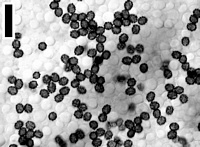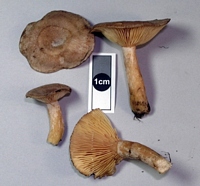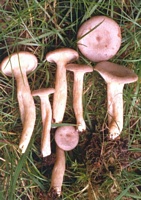|
 Lactarius glyciosmus Lactarius glyciosmus
SynonymsAgaricus glyciosmus
BiostatusPresent in region - Exotic
Images (click to enlarge) | 
Caption: spores in melzer's. Scale = 20um.
Owner: J.A. Cooper | 
Owner: J.A. Cooper | 
Owner: J.A. Cooper | 
Owner: J.A. Cooper |
Article: McNabb, R.F.R. (1971). The Russulaceae of New Zealand. 1. Lactarius DC ex S.F. Gray. New Zealand Journal of Botany 9(1): 46-66 (http://www.rsnz.org/publish/abstracts.php).
Description: pileus: 3-6 cm diam., plano-convex and typically umbonate when young, centrally depressed and usually centrally papillate at maturity, dry, azonate, glabrous or finely innately squarrose, greyish lilac, pallid greyish brown with faint lilac tints, or brownish grey with leaden tints; margins strongly involute when young, slightly incurved at maturity, entire. Cuticle composed of ± repent, interwoven, hyaline, thin-walled or slightly thick-walled, septate hyphae 2-5.5 µm, diam. lamellae: sub-decurrent to decurrent, moderately crowded, thin, simple, to 5 mm deep, pallid pinkish buff; lamellulae present in 3 unequal series; latex rather watery, white, unchanging on exposure to air. stipe: 2-5 cm long, ± equal, 0.7-1.1 cm diam., solid, dry, glabrous to subglabrous, concolorous with pileus or paler; flesh sordid white to pallid fawn, unchanging. Cuticle similar to that of pileus. spores: spore print not obtained; spores broadly elliptical to obovate, obliquely apiculate, apiculus to l µm long, 7.5-10 X 6.5-8 µm, ornamentation of fine to moderately coarse amyloid ridges to 1 µm high forming an incomplete or almost complete reticulum, and sparse isolated crests; plage indistinct. hymenium: basidia hyaline, clavate, 35-47 X 7.5-10 µm, 4-spored, sterigmata to 7 µm long; pleurocystidia scattered, subclavate to fusiform, hyaline, thin-walled, contents finely granular and refractive in KOH, projecting to 15 µm beyond basidia, 52-68 X 6.5-9 µm; cheilocystidia similar to pleurocystidia but shorter; pseudocystidia rare, scattered, originating from lactiferous hyphae, cylindrical to strangulate, not projecting beyond basidia, to 5 µm diam. hymenophoral trama: homiomerous, composed of lactiferous hyphae and rather loosely interwoven connective hyphae; subhymenium of closely interwoven hyphae appearing cellular in section. context of pileus: pallid fawn, unchanging, soft. smell: faintly of coconut. taste: mild at first, becoming slightly acrid. chemical characters: formalin n.r.; phenol - slowly deep vinaceous; FeSO4 - darkening; guaiacol - salmon pink darkening to brick red; KOH on pileus - yellowish brown; on context - n.r.; NH4OH on pileus and context - n.r.
Notes: Lactarius glyciosmus is an introduced species. It is indigenous to temperate regions of the Northern Hemisphere where it is typically associated with broadleaved trees, particularly Betula. The species is characterised by the small, umbonate or papillate fructifications smelling faintly of coconut, and the slowly acrid taste. It was placed in sect. Russulares subsect. Colorati by Singer (1962).
|